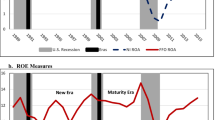Abstract
This paper examines a firm’s investment/financing decision when it uses loan-commitment-type debt with performance-sensitivity features. This analysis is of interest because most corporate borrowing today is by means of private debt, which tends to be of the loan-commitment type as well as contain performance-sensitivity provisions. We show that, except for the case of low leverage ratio, performance-sensitive debt makes shareholders better off relative to fixed-coupon debt. In particular, when the leverage ratio is chosen optimally, performance-sensitive debt dominates fixed-coupon debt and the resulting addition to shareholder wealth can be economically significant for reasonable parameter values. Therefore, it is not surprising that performance-sensitive debt has become so popular in the private debt market. The magnitude of shareholder wealth created by using performance-sensitive debt rather than fixed-coupon debt is an increasing function of earnings growth rate and tax rate, and a decreasing function of interest rate, earnings volatility and bankruptcy cost. Therefore, performance-sensitive debt financing is more likely to be used when earnings growth rate and tax rate are high, and interest rate, earnings volatility and bankruptcy cost are low.


Similar content being viewed by others
Notes
A small fraction of PSD has the opposite feature, i.e., coupon falls when firm performance declines, in order to reduce the firm’s default risk; see Manso et al. (2010) for details.
As mentioned in Sect. 2.1, when θ = 0 our PSD becomes equivalent to the traditional fixed-coupon debt.
All derivations are available from authors on request.
Mauer and Sarkar (2005) use r = 5 % and convenience yield δ = 2 %. Since the convenience yield is given by δ = r−μ, the implied growth rate is μ = 3 %.
The investment cost is higher than that in Mauer and Sarkar (2005) because our model has no fixed operating cost.
References
Asquith P, Beatty A, Weber J (2005) Performance pricing in bank debt contracts. J Acc Econ 40(1–3):101–128
Bradley M, Roberts MR (2003) Are bond covenants priced? Duke University Working Paper
Chang C-C, Chen M-Y (2012) Re-examining the investment-uncertainty relation in a real options model. Rev Quant Financ Acc 38(2):241–255
Chava S, Jarrow R (2008) Modeling loan commitments. Financ Res Lett 5(1):11–20
Denis DJ, Mihov VT (2003) The choice among bank debt, non-bank private debt and public debt: evidence from new corporate borrowings. J Financ Econ 70(1):3–28
Goldstein R, Ju N, Leland H (2001) An EBIT-based model of dynamic capital structure. J Bus 74(4):483–512
Houston J, James C (1996) Bank information monopolies and mix of private and public debt. J Financ 51(5):1863–1889
Kashyap AK, Rajan R, Stein JC (2002) Banks as liquidity providers: an explanation for the coexistence of lending and deposit-taking. J Financ 57(1):33–73
Koussis N, Makrominas M (2015) Growth options, option exercise and firms’ systematic risk. Rev Quant Financ Acc 44(2):243–267
Koziol C, Lawrenz J (2010) Optimal design of rating-trigger step-up bonds: agency conflicts versus asymmetric information. J Corp Financ 16(2):182–204
Lando D, Mortensen A (2004) On the pricing of step-up bonds in the European telecom sector. J Credit Risk 1(2):71–110
Leland H (1994) Corporate debt value, bond covenants and optimal capital structure. J Financ 49(4):1213–1252
Lyandres E, Zhdanov A (2010) Accelerated investment effect of risky debt. J Bank Financ 34(11):2587–2599
Manso G, Strulovici B, Tchistyi A (2010) Performance-sensitive debt. Rev Financ Stud 23(5):1819–1854
Mauer DC, Sarkar S (2005) Real options, agency conflicts, and optimal capital structure. J Bank Financ 29(6):1405–1428
Myklebust TA (2012) Performance sensitive debt—investment and financing incentives. Working Paper
Park KY, Lee D (2013) Agency costs and corporate liquidity demand: evidence from bank loan commitment usage during the financial crisis. Working Paper
Riddiough TJ, Thompson HE (1996) Valuing debt in a complex capital structure. Rev Quant Financ Acc 6(3):203–221
Sarkar S, Zhang C (2015) Underinvestment and the design of performance-sensitive debt. Int Rev Econ Financ 37:240–253
Sundaresan S, Wang N (2007) Investment under uncertainty with strategic debt service. Am Econ Rev 97(2):256–261
Tsai S-C (2005) Dynamic models of investment distortions. Rev Quant Financ Acc 25(4):357–381
Author information
Authors and Affiliations
Corresponding author
Rights and permissions
About this article
Cite this article
Sarkar, S., Zhang, C. Loan-commitment borrowing and performance-sensitive debt. Rev Quant Finan Acc 47, 973–986 (2016). https://doi.org/10.1007/s11156-015-0527-z
Published:
Issue Date:
DOI: https://doi.org/10.1007/s11156-015-0527-z



